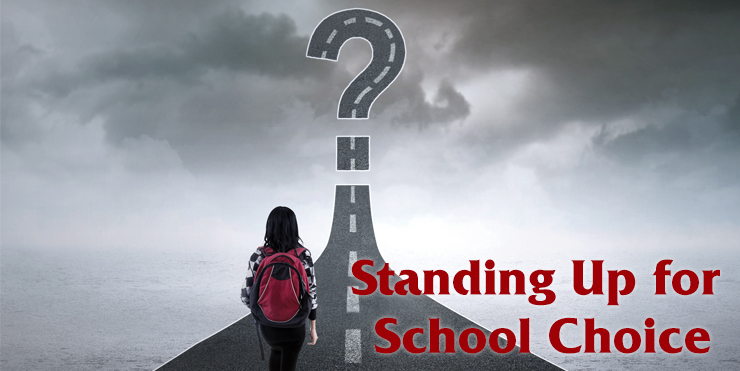 By now, area families who’ve applied to independent, charter and select public schools have received acceptance (and, in some instances, rejection) letters for the 2017-2018 academic year, mulled over options and made their final decisions. It would seem the hard part is over. But for many, it’s just beginning.
By now, area families who’ve applied to independent, charter and select public schools have received acceptance (and, in some instances, rejection) letters for the 2017-2018 academic year, mulled over options and made their final decisions. It would seem the hard part is over. But for many, it’s just beginning.
The Baltimore area’s wide array of school options creates a unique academic landscape, where choices are plentiful and loyalties fierce. It’s no joke, after all, that when two adults from Baltimore meet, the first question often asked is: “Where did you go to school?” By that, they may very well be referring to grade school. To folks who grew up in another part of the country or even a neighboring state, Baltimoreans’ passionate feelings about their alma maters can seem downright ridiculous.
One local mom, originally from a suburb of Philadelphia, says she never could have envisioned the family divide that ensued when her son chose to go to a high school other than that which his cousins, uncles and grandfather attended. When he was a little boy, relatives’ holiday and birthday gifts always included t-shirts, sweatshirts and other gear from ‘said school.’ For years, the family assumed he would follow the footsteps of his male relatives. But as the time to choose a high school drew near, doubts emerged.
As the boy’s immediate family began to look at all their options and consider where the young student would thrive most readily, they realized the school to which his extended family members assumed he was destined might not be the best fit after all.
“We decided to pursue other, smaller schools where he’d have more opportunities [to get involved],” says his mom. Ultimately, the family chose not to follow in the footsteps of the boy’s male relatives. And for the next four years, they endured a cold war of sorts.
Miffed relatives aside, this family’s story can be considered a success. They ignored external pressures and chose the school they believed would be best for their son; it turned out to be an excellent fit academically, athletically and socially. While this sounds like pure logic, countless local families can relate to the complex and often emotionally fraught process of picking a school for their children.
Weighing a school’s reputation
As if contending with pressure from relatives, acquaintances and even business associates isn’t enough of an obstacle to school selection, families also confront long-held preconceived notions about schools that may or may not be accurate, explains local educational consultant Becky Reynolds.
“The reputation just sticks with schools in Baltimore, especially if you’re dealing with third- and fourth-generations,” Reynolds says. “It’s very hard in this provincial area for the schools to break away from what they are and who they serve.”
And yet, adds Reynolds, director of Towson-based School Search Group, some local schools have changed dramatically over the years. McDonogh, she points out, originated as an all-boys military academy. Now, it is a non-military co-ed school. St. Paul’s formed to provide education to orphaned boys. Currently, its lower school (grades K through 4) is co-ed and few if any orphans are enrolled.
The bottom line is that, too often, parents start their school search armed with incorrect information and biases—either their own or those widely shared. Cutting through the clutter to reach a sound and informed decision is possible. It involves personal research and an open mind.
“We tell families to see for themselves what a place is really like. Oftentimes, families may be surprised and delighted to discover that a school may, in fact, be a very good match, even though the reputation may not make it seem that way,” says Peter Baily, executive director of the Association of Independent Maryland & DC Schools (AIMS).
Strategies for sizing up a school
While Baily suggests that families utilize traditional routes like ‘shadow’ days and open houses to familiarize themselves with schools, he urges them not to stop there. He recommends that families attend school-wide events outside the school day, like sporting events and musical performances. And when families do visit schools, Baily tells them to look with an analytical eye.
“Pay attention to how students move about the campus, how happy they look, how involved in their work they are and what the spirit of the school is like,” he says.
Closely observing the students and faculty members within a school can be critical to the decision-making process. But, urges Reynolds, there’s more. Families need to assess honestly how well their own children will “fit in” to a given school environment.
First and foremost, advises Reynolds, consider the academic match. But that’s not all. “You’ve also got to see if a school has the programs to support that child’s interests and talents,” she says. Cultural fit cannot be overlooked either, advises Reynolds. She asks this question about her own clients: “Is this a structured, conservative family or a more liberal family that wants a more relaxed environment?”
Carefully considering the many facets of a school relative to a child’s talents, interests and outlook helps families formulate an informed decision regarding an overall match. The process takes time and patience—not individual biases or hearsay from the broader community.
“There is no best school. It’s only what’s best for your child,” Reynolds says.









